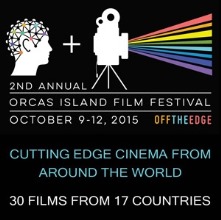— by Paula Treneer, reprinted upon request —
OIFF Film Review: “Free to Rock”, a must-see documentary directed by Jim Brown:
Orcas Island Film Festival brought a notable contribution to the genre of music documentaries with a preview showing of “Free to Rock”, directed by four-time Emmy Award winner Jim Brown. The preview showing was followed by a Q&A with one of the film’s producers, Nick Binkley, Valery Saifudinov, a Latvian-born pioneer of the movement, and Joanna Stingray, the musical producer who created the Red Wave album. Valery Saifudinov, who emigrated to California following his years in the underground Soviet music scene, treated viewers to a live performance Saturday evening at the Random Howse gala celebration.
The documentary, ten years in the making according to the Q&A, was supported by a NEA grant and based on Binkley and Valery’s idea of demonstrating the importance of cultural “soft” power, specifically in demonstrating how U.S. rock and roll infiltrated Russian youth culture and accomplished a communication between the two countries’ youths, despite the significant opposition of the Russian political establishment. The film is narrated by Kiefer Sutherland and features lengthy interview footage with leading Russian musicians, including Stas Namin, Latvian Pete Anderson and Billy Joel and Mike Love of the Beachboys, and Joanna Stingray, who was an American member of the underground music scene and introduced Russian rock and roll to US audiences
The film journeys across the story arc of the movement beginning with Cold War footage featuring the CIA’s role in the development of Radio Free Europe, Elvis Presley’s induction into the US Army, the progression of underground rock bands, and the increasing pushback from the totalitarian government. Some of the documentary’s most hilarious footage includes the Communist government’s officially sanctioned rock music, the VIA bands. The interviews with key members of the Russian movement depict the heroic challenges and lifelong commitment to freedom of musical expression made by those who contributed to this historic moment. One compelling anecdote told by a current Fender guitar builder of his Soviet-era electric guitar creations, built in his underground workshop based on designs found in the Fender guitar catalog, showed the spectacular ingenuity of the Russian creative spirit during this period. The footage depicting the Soviet security forces forgoing their assigned roles of pushing the excited concert spectators back into their seats and joining in the excitement, even enthusiastically tossing their military caps, is moving documentary history.
The film’s strengths include superb editing of historical footage, fascinating interviews with Russian, Latvian and American members of the movement, great pacing and documentation of historical musical events like the Moscow Music Peace Festival and the largest rock concert ever held, outside Moscow following the dismantling of the Berlin Wall. The film includes interviews with former President Jimmy Carter, Mikhail Gorbachev, a KGB General (later accused of state treason, now resident in the US), Joseph Nye, and features footage of performances by Elvis, the Beatles, the Beach Boys, Dean Reed (the American defector), the Nitty Gritty Dirt Band, Stas Namin, Latvian Pete Anderson, Andrei Makarevich, Valery Saifudinov, Leningrad’s KINO, and others. Jimmy Carter’s son’s role in introducing his father to the possibility of sending the Nitty Gritty Dirt Band to the Soviet Union was a fascinating historical footnote.
**If you are reading theOrcasonian for free, thank your fellow islanders. If you would like to support theOrcasonian CLICK HERE to set your modestly-priced, voluntary subscription. Otherwise, no worries; we’re happy to share with you.**








